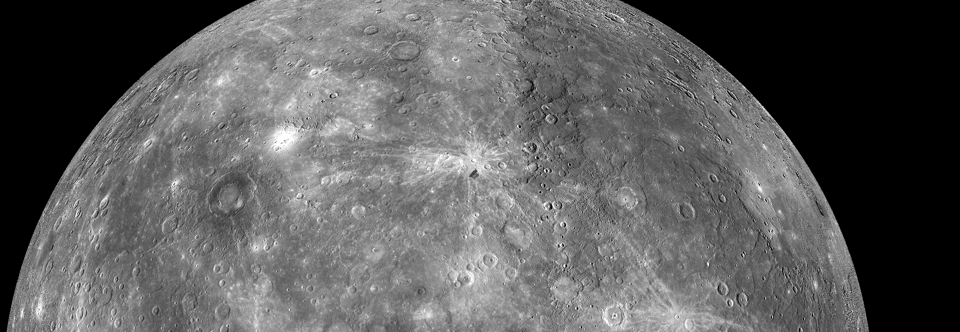Comet C/2006 P1 McNaught showing dust fragmentation in the tail
Ice Filled Crater on Mars
Artist’s view of Kepler 11, a planetary system with 6 confirmed exoplanets.
Volcanic Plume on Io viewed against Jupiter
Cracked ice on Europa caused by tidal flexing from Jupiter
 The surface of Jupiter’s satellite Europa, the second large moon from the planet, is cracked. Reflection spectra show that the surface material is mostly clean ice, while images show very few impact craters, indicating that the surface is young. In addition, several lines of evidence show that Europa possesses a subsurface ocean of liquid water (the best evidence, from induced currents that flow in Europa as it cuts through Jupiter’s magnetosphere, was discovered by UCLA scientists B. Khurana and M. Kivelson). Together, the known properties suggest that the surface is a bit like the arctic polar cap of the Earth, with ice sheets floating on water and stress-cracked into polygonal platelets that sometimes collide and may even overturn. The global scale cracks in the picture are a few kilometers wide and a few 100 meters deep, and spectrally distinguished from their surroundings by entrained salts and other materials presumably oozed up from below. These large-scale cracks form patterns dictated by global stresses, caused by planetary perturbations as Europa orbits Jupiter. Smaller scale cracks and other morphological features indicate that Europa’s ice shell may be as thin as 3 km, in places.
The surface of Jupiter’s satellite Europa, the second large moon from the planet, is cracked. Reflection spectra show that the surface material is mostly clean ice, while images show very few impact craters, indicating that the surface is young. In addition, several lines of evidence show that Europa possesses a subsurface ocean of liquid water (the best evidence, from induced currents that flow in Europa as it cuts through Jupiter’s magnetosphere, was discovered by UCLA scientists B. Khurana and M. Kivelson). Together, the known properties suggest that the surface is a bit like the arctic polar cap of the Earth, with ice sheets floating on water and stress-cracked into polygonal platelets that sometimes collide and may even overturn. The global scale cracks in the picture are a few kilometers wide and a few 100 meters deep, and spectrally distinguished from their surroundings by entrained salts and other materials presumably oozed up from below. These large-scale cracks form patterns dictated by global stresses, caused by planetary perturbations as Europa orbits Jupiter. Smaller scale cracks and other morphological features indicate that Europa’s ice shell may be as thin as 3 km, in places.
Planetary Insights – Exoplanets
Planetary Insights – Planet Formation
Planetary Profiles – Hilke Schlichting
Dec 1 2011: Astrobiology of Lakes
Speaker:
Dr. Darlene Lim
NASA Ames Research Center
Abstract:
Analog field science and exploration research can approximate the
Earth’s past as well as humanity’s future in space. Such is the case
with the research of the Pavilion Lake Research Project (PLRP). The
PLRP, a multi-disciplinary, science and exploration endeavor, focuses
on understanding the morphogenesis of modern microbialites in Pavilion
Lake, British Columbia, Canada. Over the years, the PLRP has employed a
suite of lab and field based methods to accomplish its scientific and
exploration goals. The field research demands the seamless integration
of science and exploration field activities in an underwater
environment inherently hostile to humans. The physical, mental and
operational rigors associated with PLRP field science and exploration
activities are comparable to extra-vehicular activities (EVA) where
scientific exploration is a key driver. These working constraints are
not simulated, but real and inextricable from the PLRP’s activities.
The PLRPs analog science activities provide a real science setting in
which to inform the development of scientific and mission operation
architectures, train astronauts as field scientists, test technology,
evaluate technical requirements to meet scientific needs, and design
science backroom team protocols.
Darlene will present a synopsis of the PLRP science and exploration
activities with a focus on this past year’s field season at Kelly Lake,
BC, Canada.





